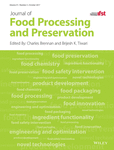Optimization of the extraction process of antioxidants from loquat leaves using response surface methodology
Abstract
This study is designed to optimize the extraction of polyphenolics and antioxidant potential of loquat leaves using response surface methodology (RSM). Three levels and three variables Box-Behnken experimental design in combination with RSM was applied. Independent variables were solvent concentration (10–90%), temperature (20–60°C) and time (60–180 min), while investigated response was total phenolic content as well as antioxidant activity. The experimental results were fitted to a second-order quadratic polynomial model, and they showed a good fit to the proposed model. In order to assess model fitness and determine optimal conditions, for maximal phenolic content and antioxidant activity, analysis of variance was employed. Determined optimized conditions for maximizing yield of antioxidant compounds were within the experimental range: ethanol concentration of 88.4%, extraction temperature of 28°C, extraction time of 70.8 min. Under these conditions, the predicted maximum values were TP-77.18 mg GAE/g, DPPH-80.42 mg TE/g, CUPRAC-308.87 mg TE/g and FRAP-164.12 mg TE/g.
Practical applications
Plant phenolics have remarkable biological activities including antioxidant, antimicrobial and anticancer. Therefore, their extraction techniques have gained more attention in recent years. This study was designed to detect optimal extraction conditions of independent factors (i.e. solvent concentration, temperature and time) in order to obtain the highest yields of phenolics from loquat leaves as well as antioxidant activity. This study could be valuable for designing new nutraceutical and functional food ingredients in terms of high recovery of phenolics from loquat leaves.




